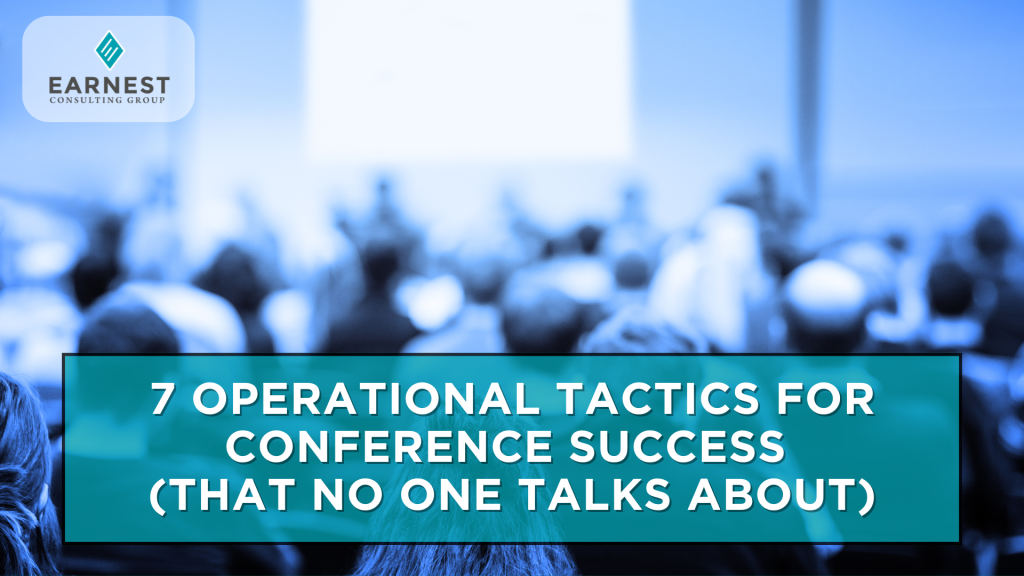7 Operational Tactics for Conference Success (That No One Talks About)
May 14, 2025 | Government
We’ve all read the lists about what to do and not do at conferences—have a plan, network smart, follow up. But here’s the thing: success at conferences isn’t just about being present and pleasant. It’s about building systems that work for you before, during, and after the event.
So if you’ve already got the basics down, here’s a deeper operational playbook to help you turn conference attendance into repeatable ROI.
1. Start With a Campaign Mindset, Not a Calendar Entry
Too many companies treat conferences as one-off events. They show up, shake hands, pack up—and go home without a measurable outcome. If you want results, treat the event like a mini-campaign:
- Set goals: X number of decision-maker conversations, Y number of follow-up meetings booked.
- Assign roles: Who’s responsible for outreach before the show? Who’s taking the lead for documenting intelligence? Who’s setting reminders for follow-up?
Approach it like an opportunity window, not just a date on the calendar.
2. Build a Pre-Show CRM Segment
Don’t wait until you’re standing at the booth to start making connections. Create a segment in your CRM 30 days before the conference of everyone who’s attending (or likely to).
This could include:
- Past clients you know are going
- Target agency officials listed in the exhibitor or attendee directory
- Small business liaisons or prime contractors you’ve been trying to meet
Start your outreach 2–3 weeks before the show. Even something as simple as:
“Are you attending VETS25? I’ll be there too—would love to connect briefly during the event.”
…can lead to a powerful introduction before the conference doors even open.
3. Build a Real-Time Debrief System
After every meaningful conversation, debrief immediately. Don’t rely on memory when you’re back at the office.
Here’s a fast format you can use:
- Name and title
- Agency or company
- What we discussed
- Next step (email, brief, intro, proposal, etc.)
- Date/time for follow-up
If you’re in a team, use a shared Google Sheet or CRM tag to track these in real time. This isn’t about being over-organized—it’s about making sure great conversations don’t die in your luggage.
4. Prepare Your “Action Asset” in Advance
Before the show, create one follow-up asset that makes reconnecting easy. Think of this as your value-based handshake email attachment.
Examples:
- A one-pager about your capabilities with specific past performance metrics
- A two-minute video that shows what you do
- A mini case study relevant to the audience
Don’t wait until after the conference to build this. Get it ready ahead of time so you can send it within 48 hours of your follow-up.
5. Get the Right Intel at the Right Booths
You’re not just walking the floor to meet buyers—you’re also gathering intel. At each booth you visit, train yourself to ask:
- “Do you currently buy X?”
- “What contract vehicles do you use for that?”
- “Do you partner with small businesses for that?”
Capture this in your notes. You’re not just there to sell—you’re there to scout.
6. Know What NOT to Bring Back
Some companies come back from conferences with a duffel bag full of random brochures, unqualified leads, and vague ideas. The operational pros come back with:
- A short list of top-tier follow-up prospects
- Clear notes on opportunity fit
- Specific actions tied to outcomes (not just “send them something”)
If it’s not actionable, it shouldn’t clog your pipeline.
7. Block the Day After
This might be the most tactical advice in this entire article: block your calendar the day after the conference.
No meetings. No sales calls. No internal busywork.
That day is sacred—for follow-up, CRM entry, thank-you emails, and setting your next steps. Don’t lose momentum by jumping right back into normal work.
Final Word:
Conferences aren’t magic. The opportunities are there, but only if you build the operations to capture them. Treat each one like a targeted campaign. Prep like a pro. Follow up like it’s your job—because it is.
Execution wins.
See you at the next event.
If you like what you see in this article and are ready to get to work on increasing your product sales margins, click here to schedule a call with me. Let’s put together a plan that works
« Back to Blog Home




